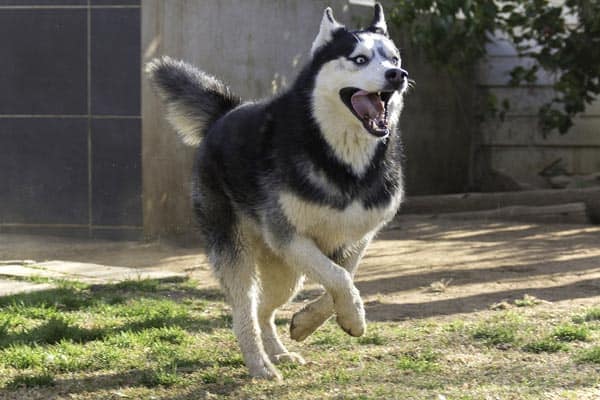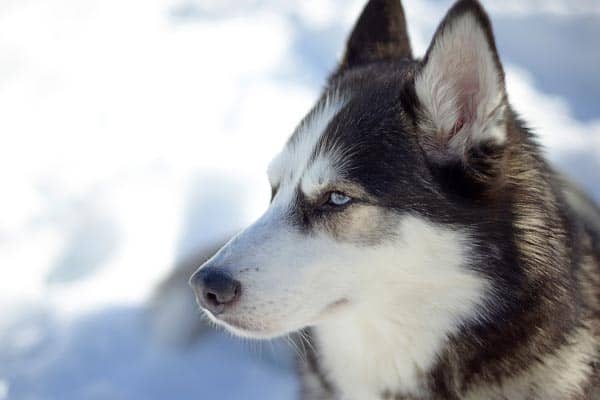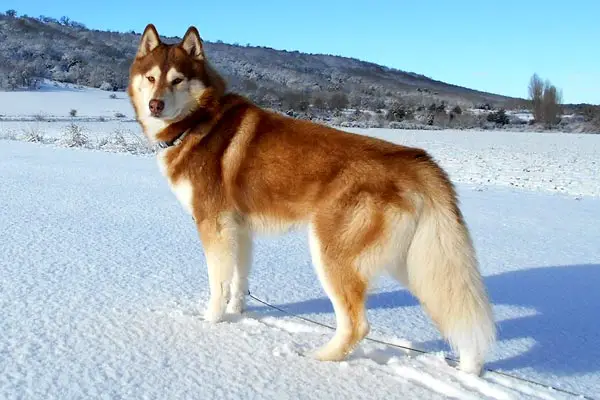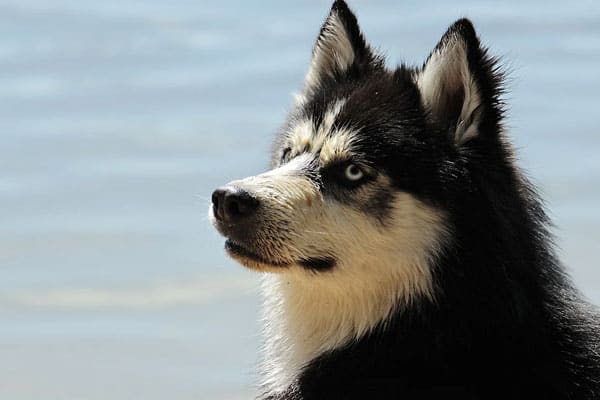How Fast Can a Siberian Husky Run: Meet the Dog That Lives for Running

The Siberian Husky is one of those dogs famous for their running ability. Books have been written, and movies have been made to commemorate their excellent athletic and running abilities.
And in fact, these dogs were bred to run. While today the Siberian Husky is a famous companion canine, not too many decades ago, these dogs were only bred to work.
In this article, get the inside scoop on the Siberian Husky’s legendarily fleet feet. How fast can a Siberian Husky run? Let’s find out!
How Fast Can a Siberian Husky Run?
A Siberian Husky is a dog that runs for the love of running, not just for work or exercise.
Adult Siberian Huskies can readily reach top speeds of up to 31mph (50km) when running full-tilt and not hauling or pulling anything. They can easily reach speeds of about half that when hauling the weight equivalent to an adult man.
Just How Fast Is the Siberian Husky Dog?
As Rover points out, the Greyhound, arguably the fastest purebred dog breed ever bred, can run twice as fast as Olympic medalist Usain Bolt running at his fastest speed ever!
This means that even the fastest humans on the planet are only as fast as dogs of average running ability. And the Siberian Husky dog is not a dog of just average running ability.
As noted canine researcher Stanley Coren explains in Psychology Today, the running ability of the modern domestic dog could arguably be considered the fastest land animal.
This might not be true in sheer speed. But in terms of sustained speed over longer distances, many super-fast dog breeds can attain incredible speeds and maintain those speeds over many miles – or even hundreds of miles.
While a Greyhound dog, which many believe to be the world’s fastest dog, can achieve and maintain speeds up to 43mph, the Siberian Husky is no slouch, coming in at 13th place with 30mph.
As Stanley Coren explains, the Siberian Husky may be the fastest dog breed in the world for super-marathon races such as the Iditarod, the legendary sled dog race. The Iditarod race covers a distance of 1,161 miles.
Sled dog teams of 16 dogs per team run up to 10 to 12 hours per day for up to 125 miles per day for up to 14 hours to get from start to finish. This is pretty amazing in itself.
But consider this: the sled dog teams are also hauling a sled! The typical sled weighs more than 200 pounds. But there’s more. Consider the weather: when you factor in wind chill, the temperature can quickly feel like -100F as the dogs run.
No other land mammal can even approach this type of endurance and speed combination. So this explains why the Siberian Husky is made to run and cannot resist the opportunity when it arises.
Why Can Siberian Husky Dogs Run So Fast?
As the Anchorage Daily News (ADN) explores, scientists have long been intrigued by what allows the Siberian Husky dog breed to run so fast, so far, and for such a long period at a stretch.
As ADN explains, the modern dog is the canine equivalent of an ultra-marathoner, with enhanced aerobic ability, which means the ability to make high-efficiency use of oxygen intake for stamina.
While racing, the Siberian Husky may eat as many as 12,000 calories per day while running, a massive caloric intake for a dog that rarely ever tops 60 pounds fully grown. Their diet is very high in fat to pack as many calories as possible into each bite.
As Scientific American explains, the massive intake of calories – mostly from fat – for a dog of only 40 to 60 pounds has been hard for canine biologists to understand.
Studies have revealed that sled dogs have a different type of metabolism that can switch back and forth when they need to metabolize fat calories quickly and directly.
The sled dogs use a different pathway to store and release energy that doesn’t negatively impact the muscles or over-task the cells to deliver this energy.
As Live Science highlights, another part of the secret of the Siberian Husky’s running success lies in how these dogs manage the physical impacts of stress.
Unlike human runners, the dogs’ bodies stop the damage to muscle cells that occurs in every other species, including humans. Within one day of beginning a long trek, the dogs’ muscle cells stop getting damaged somehow.
Scientists believe this is why the Siberian Husky can run incredible distances daily for days and not sustain any lasting ill effects of such efforts.
There is much more yet to study and learn. Still, researchers are excited about how studying Siberian Huskies may help people become healthier and support human athletes to reach peak performance.
The History of Famous Fast, Strong Siberian Huskies
The Siberian Husky Club of America recounts that the modern Siberian Husky breed started in north-eastern Asia.
The nomadic Chukchi tribal people relied on teams of Siberian Husky dogs for hauling supplies, transporting them as they moved about in search of food, and helping them in the hunt.
Siberian Huskies get their breed name from the area in Asia called Siberia.
This distinguishes actual purebred Siberian Husky dogs from another loosely categorized group of working sled dogs known as “Alaskan huskies” or simply “huskies.”
While these dogs all share certain common traits, such as double-layer coats and similar facial structures, the Siberian Husky is a purebred dog breed separate from all the others.
Famous Siberian Huskies and Their Running Talents
According to Aussie Exile Siberian Husky kennel, Balto, Togo, and Charlie are the three most famous modern Siberian Huskies that have ever lived.
Balto’s story
Balto’s story was made into a movie by the same name as Balto’s True Story reports. Balto was a Siberian Husky on the team that relay-raced life-saving medication to an isolated village in Nome, Alaska.
While Balto was the lead dog in the sled dog team that ran the final leg of the relay, truly this was a team effort involving more than 100 sled dogs. Balto ran 55 miles flat out at the head of his team to deliver the diphtheria serum to the people.
Togo’s story
Togo was a part of the same serum run to Nome, Alaska, and he ran more than double Balto’s distance. But he is less well-known because he wasn’t on the final team that ran into Nome.
Togo’s story was recently also made into a movie by the same name, as Outside Online reports. The story showcases both Togo and Balto and the other sled dogs that contributed to the 625-mile serum run.
One of the most amazing facts about Togo’s run of more than 100 miles is that he was 12 years old when he made the run! As the American Kennel Club (AKC) breed profile points out, the average life span for a Siberian Husky is 12 to 14 years.
Andy’s story
Andy is a real-life Siberian Husky hero that won his musher, Rick Swenson, four separate Iditarod racing titles.
Andy the Husky lived to an incredible 20 years old and earned several other championship titles for Swenson and his canine sled dog team. He ran for more than a decade.
There are many other equally famous, heroic, and brave Siberian Huskies whose exploits have been turned into books and movies for people of all ages.
Special Problems When Keeping a Siberian Husky As a Pet
The Siberian Husky has such a solid innate instinct to run that new dog owners are warned never to let their dogs off-leash in an open area.
The Siberian Husky’s instinct to run – not to get somewhere and not to get away from something but simply for the joy of running – is so strong that they are escape artists bar none.
As the Siberian Husky Club of America states, it is imperative to escape-proof your backyard from every angle – above, below, and everything in between, including the gates.
Siberian Huskies are also driven to be with their people, and many times a dog left in the backyard will escape trying to find their people. But this often has a very sad ending instead.
Siberian Huskies kept as companion canines need daily exercise and activity to stay healthy and happy. Once your dog manages to escape and starts running, likely, they will not remember how to get home.
Siberian Huskies don’t have any frame of reference for roads and vehicular traffic and can quickly get confused or scared and end up causing accidents.
This means there is also a significant risk that your Siberian Husky will run out into traffic and get killed. Many owners have found out the hard way that escaped Siberian Huskies will not return when called, and many dogs have been lost in this way.
How to Escape-Proof Your Yard Before Getting a Siberian Husky
If you are considering adding a Siberian Husky to your family, you must take special precautions before you bring your puppy home.
Bama Huskies breeder and kennel explain that Siberian Huskies use three primary tactics to escape from a yard: digging, climbing, and jumping.
Luckily, there are unique things you can do to keep your Siberian Husky from using any of these handy athletic abilities to escape from your backyard.
Dig-proof your yard
You can use concrete blocks or bricks buried underneath the fence to keep your Siberian Husky from digging out. Reinforcing with chicken wire can be handy for puppies.
Climb-proof your yard
Many Siberian Huskies use the “fence within a fence” system to keep your dog in no matter what. Even if your Husky manages to climb the fence, they will only find an even higher climb-proof smooth fence on the other side.
Jump-proof your yard
The only way to effectively jump-proof your yard is to place a barrier at the top of the fence that prevents your dog from making it over. Inwardly-curved barriers or high shelves can make a fence impassible from the inside out.
You will want to combine all these tactics to keep your Siberian Husky inside your fence completely.
Huskies are also very smart dogs that can quickly figure out how to operate latches and levers to open a fence gate.
So you will need to “dog-proof” your fence gate by moving the latch to the outside and placing it too high up for your dog to access.
Siberian Huskies Live to Run and Need to Run Daily
Finally, it is vital to remember that being able to run is a huge part of raising and caring for a happy, healthy pet Siberian Husky.
If you don’t run, you must find another outlet for your dog, such as enrolling in canine athletics or using a motorized vehicle to “run” alongside your dog.
When you understand how important running is to your dog, you will be able to provide for this essential Siberian Husky need.
See a Siberian Husky Running Full Out
This owner-made video shows a Husky named Maya running at 31mph (50km). The owner also states that Maya was pregnant at half-term when the video was taken, which means she was heavier than she would have otherwise been.





